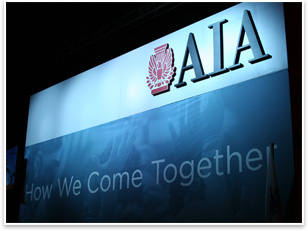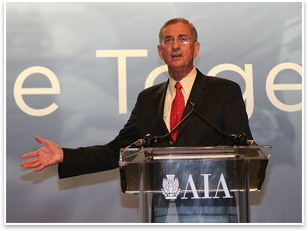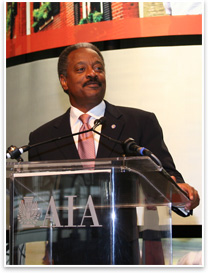| ‘We the People’ Gather in Boston for the 140th AIA National Convention
 Summary: “Welcome to Back Bay and the Brahmans of Beacon Hill, Haahvahd and MIT, Olmsted’s Emerald Necklace and Richardson’s glorious Trinity Church, Faneuil Hall and Fenway Park, patriots and pilgrims, chowder and beans . . . Welcome to Boston and the 140th National Convention of The American Institute of Architects!” declared AIA President Marshall E. Purnell, FAIA, as he convened the opening session of the AIA national convention on May 15 in Boston. Summary: “Welcome to Back Bay and the Brahmans of Beacon Hill, Haahvahd and MIT, Olmsted’s Emerald Necklace and Richardson’s glorious Trinity Church, Faneuil Hall and Fenway Park, patriots and pilgrims, chowder and beans . . . Welcome to Boston and the 140th National Convention of The American Institute of Architects!” declared AIA President Marshall E. Purnell, FAIA, as he convened the opening session of the AIA national convention on May 15 in Boston.
Hail to the chiefs
Purnell began the morning’s session with a recollection from last year’s convention, during which AIA President RK Stewart noted that: “We stand on the shoulders of giants”; whatever we’re able to accomplish has been made possible by the creativity, vision, and hard work of those who came before us. “No ‘giants’ have worked harder on behalf of the AIA than the distinguished men and women I’m about to bring on stage,” Purnell said, as he welcomed the former presidents of the AIA. In all, 22 former presidents took the stage, representing terms of service that date back to 1972.

On a more somber note, Purnell led a special tribute to two former AIA presidents who passed away last year: The AIA’s 46th President, Rex Whitaker Allen, FAIA, and the 60th president, George M. Notter Jr., FAIA. “Please join me in a moment of silent celebration for the gifts of these two remarkable men.”
 What are we the people doing for others? What are we the people doing for others?
Purnell then set the tone for the convention as he defined its theme, “We the People,” in his powerful presentation. “Four syllables, three words. Perhaps the three most powerful words after ‘Let there be light.’ God’s word created the world. The words written by James Madison changed it,” he said. “ . . . Those words are magic! They escape the tyranny of their time. ‘We the People!” Having the skills to make communities better puts a special responsibility on the architectural profession to be inclusive and encompass people who might not otherwise be represented, Purnell said. (Read the full text of Purnell’s speech.)
 Purnell ended his speech with the query that Martin Luther King described as life’s most persistent and urgent question: “What are we doing for others?” The quotation offered proper segue to his introduction of the keynote speaker, Millard Fuller, the self-made millionaire who founded Habitat for Humanity International in 1976 and the Fuller Center for Housing in 2005. Purnell ended his speech with the query that Martin Luther King described as life’s most persistent and urgent question: “What are we doing for others?” The quotation offered proper segue to his introduction of the keynote speaker, Millard Fuller, the self-made millionaire who founded Habitat for Humanity International in 1976 and the Fuller Center for Housing in 2005.
“We the people should leave out none of the people,” Fuller said in keeping with the convention theme. The sign of a great country, he said is: “How do we take care of the least?” We can’t squander the potential of the next generation. “Give every child a chance to rise to his or her highest potential, whatever that might be,” exhorted the man who recruited President Carter to joint Habitat in 1984. “Be a blessing to the least among us.” (Read a full report on Fuller’s speech.)
 Architecture students reach out Architecture students reach out
“Reaching out to underserved constituencies is no stranger to the work of AIAS. They have raised the profile of our profession in neighborhoods that have never seen an architect," Purnell noted, as he invited representatives of the American Institute of Architecture Students to the stage. AIAS President Andrew Caruso observed, “The AIAS ranges from eager high school students to confident graduates prepared for a professional career. Indeed, we represent students who are fiercely committed to serving society and who believe in their ability to effect change in our world through design.“ The AIAS serves some 7,000 members each year in more than 145 chapters throughout North America and beyond.
 AIAS Vice President Tony Vanky spoke about the national design-build community service program, Freedom by Design, which allows architecture students to use their knowledge and design skills to change the lives of others. “Through modest, yet significant design-build solutions, this public service program allows students to use their creativity and energy to have an impact on the lives of those with physical, mobile, and sensory impairments; the results of which improve the life safety, dignity, and comfort of those in our communities,” Vanky said. “Among our many partners who volunteer their time with our members, we are proud to have Michael Graves, FAIA, and his associates working with 5 of our almost 40 participating teams.“ AIAS Vice President Tony Vanky spoke about the national design-build community service program, Freedom by Design, which allows architecture students to use their knowledge and design skills to change the lives of others. “Through modest, yet significant design-build solutions, this public service program allows students to use their creativity and energy to have an impact on the lives of those with physical, mobile, and sensory impairments; the results of which improve the life safety, dignity, and comfort of those in our communities,” Vanky said. “Among our many partners who volunteer their time with our members, we are proud to have Michael Graves, FAIA, and his associates working with 5 of our almost 40 participating teams.“  Vanky further announced that the AIAS has secured more than $1 million of the $2 million sought through its Beyond Architecture endowment campaign. He thanked the AIA for taking the lead by making the first pledge and supporting “the power of students.” Vanky further announced that the AIAS has secured more than $1 million of the $2 million sought through its Beyond Architecture endowment campaign. He thanked the AIA for taking the lead by making the first pledge and supporting “the power of students.”
Purnell reiterated the Institute’s commitment to supporting students at every level and the potential of the next generation. The Shadow an Architect program, begun during the 2007 convention in San Antonio, has come to Boston, with the help of the Boston Society of Architects and 29 volunteers from the AIA Board. The program involves architects volunteering as mentors to accompanying disadvantaged secondary school students around the convention to show them what is possible for their own futures.
ArchiPAC pledge: Helping government help architects
“To improve our industry, to improve our communities, to improve our country, every architect needs to be involved in the political process. When times are good, or when they are bad—as I know they are for many in our profession—if we do not have a place at the table, we will simply be left behind. None of us can afford to let that happen,” said ArchiPAC National Chair, Don Brown, AIA. “ArchiPAC is a mechanism that we use to gain access to political leaders.  They are the ones who make the decisions that affect the built environment, our profession, our communities, our practices.” Brown enumerated AIA projects on the federal level: a tax deduction for income on architectural services, getting the 2030 Challenge signed into law for all federal buildings last year, and working on a green housing bill in Congress and economic stimulus packages right now. “The only way that ‘We the Architects,’ acting as one united voice, can support those who will make decisions affecting our practices and our communities is to support ArchiPAC,” Brown concluded. They are the ones who make the decisions that affect the built environment, our profession, our communities, our practices.” Brown enumerated AIA projects on the federal level: a tax deduction for income on architectural services, getting the 2030 Challenge signed into law for all federal buildings last year, and working on a green housing bill in Congress and economic stimulus packages right now. “The only way that ‘We the Architects,’ acting as one united voice, can support those who will make decisions affecting our practices and our communities is to support ArchiPAC,” Brown concluded.
| 

 Su
Su
 What are we the people doing for others?
What are we the people doing for others? Purnell ended his speech with the query that Martin Luther King described as life’s most persistent and urgent question: “What are we doing for others?” The quotation offered proper segue to his introduction of the keynote speaker, Millard Fuller, the self-made millionaire who founded Habitat for Humanity International in 1976 and the Fuller Center for Housing in 2005.
Purnell ended his speech with the query that Martin Luther King described as life’s most persistent and urgent question: “What are we doing for others?” The quotation offered proper segue to his introduction of the keynote speaker, Millard Fuller, the self-made millionaire who founded Habitat for Humanity International in 1976 and the Fuller Center for Housing in 2005. Architecture students reach out
Architecture students reach out AIAS Vice President Tony Vanky spoke about the national design-build community service program, Freedom by Design, which allows architecture students to use their knowledge and design skills to change the lives of others. “Through modest, yet significant design-build solutions, this public service program allows students to use their creativity and energy to have an impact on the lives of those with physical, mobile, and sensory impairments; the results of which improve the life safety, dignity, and comfort of those in our communities,” Vanky said. “Among our many partners who volunteer their time with our members, we are proud to have Michael Graves, FAIA, and his associates working with 5 of our almost 40 participating teams.“
AIAS Vice President Tony Vanky spoke about the national design-build community service program, Freedom by Design, which allows architecture students to use their knowledge and design skills to change the lives of others. “Through modest, yet significant design-build solutions, this public service program allows students to use their creativity and energy to have an impact on the lives of those with physical, mobile, and sensory impairments; the results of which improve the life safety, dignity, and comfort of those in our communities,” Vanky said. “Among our many partners who volunteer their time with our members, we are proud to have Michael Graves, FAIA, and his associates working with 5 of our almost 40 participating teams.“  Vanky further announced that the AIAS has secured more than $1 million of the $2 million sought through its Beyond Architecture endowment campaign. He thanked the AIA for taking the lead by making the first pledge and supporting “the power of students.”
Vanky further announced that the AIAS has secured more than $1 million of the $2 million sought through its Beyond Architecture endowment campaign. He thanked the AIA for taking the lead by making the first pledge and supporting “the power of students.” They are the ones who make the decisions that affect the built environment, our profession, our communities, our practices.” Brown enumerated AIA projects on the federal level: a tax deduction for income on architectural services, getting the 2030 Challenge signed into law for all federal buildings last year, and working on a green housing bill in Congress and economic stimulus packages right now. “The only way that ‘We the Architects,’ acting as one united voice, can support those who will make decisions affecting our practices and our communities is to support ArchiPAC,” Brown concluded.
They are the ones who make the decisions that affect the built environment, our profession, our communities, our practices.” Brown enumerated AIA projects on the federal level: a tax deduction for income on architectural services, getting the 2030 Challenge signed into law for all federal buildings last year, and working on a green housing bill in Congress and economic stimulus packages right now. “The only way that ‘We the Architects,’ acting as one united voice, can support those who will make decisions affecting our practices and our communities is to support ArchiPAC,” Brown concluded.